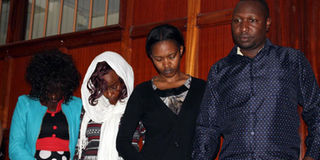Baracuda fraud case reveals major weakness in aviation law

From left: John Majiwa, Barbara Alwena, Stella Amaya and Elizabeth Kinyanjui at Milimani Law Courts on February 27, 2017 where they were charged with receiving Sh9.7 million from several people after alleging they would offer them training for piloting and crew membership. PHOTO | PAUL WAWERU | NATION MEDIA GROUP
What you need to know:
To obtain the licence, one does not need to show proof of actual aircraft, neither does the KCAA go to the ground to establish that the applicant has an aircraft.
According to industry insiders, the only thing one needs to do is to pay $1,500 (Sh153,000) if it is a new application and $500 (Sh51,000) for renewal, which is done every two years.
The Baracuda Airways case has revealed a major weakness in civil aviation law, which many people have been exploiting to start briefcase aviation companies.
The chief executive officer of Baracuda Airways Holdings, John Majiwa, who has been charged with conning unsuspecting Kenyans out of Sh9.7 million for instance, was issued with Air Service Licence by the Kenya Civil Aviation Authority (KCAA) on January 23 this year. Baracuda Airways licence is KCAA/ASL/1668. The last four digits appear to have been handwritten while the rest of the licence is typed.
To obtain the licence, one does not need to show proof of actual aircraft, neither does KCAA go to the ground to establish that the applicant has an aircraft.
According to industry insiders, the only thing one needs to do is to pay $1,500 (Sh153,000) if it is a new application and $500 (Sh51,000) for renewal, which is done every two years.
“To get an Air Service Licence (ASL) is just an application that goes through public hearing and, if found satisfactory, a licence is issued,” says Captain Gad Kamau, the chairman of Wilson Airport Aircraft Operators.
The application is done using form KCAA 0004/1.
However, KCAA director- general Capt Gilbert Kibe, who signed the Baracuda ASL, said all applicants must meet the conditions for issuance of a licence contained in the Legal Notice No 114 of the Civil Aviation (Licensing of Air Services) Regulations, 2009.
'VETTING PROCESS'
“All applications are subjected to a vetting process by the Authority including being subjected to a public hearing,” Capt Kibe said.
“Application processing fee for new applicants is $1500. A fee of $1,200 (Sh122,400 is charged for issuance of an ASL,” the KCAA director said.
Capt Kibe said there are 158 companies holding ASL in Kenya.
The public hearing by KCAA is done by the authority’s board currently chaired by Major-Gen (rtd) Charles M. Mwanzia and though the public is usually invited, just the insiders attend.
However, operators told the Nation that the public hearing just rubber-stamps the process.
“ASL is given without showing a single aircraft. There is no audit done and the public hearing is normally attended by just industry players who shy away from raising any objections,” said Capt Kamau.
Raising an objection, according to industry insiders, is seen as preventing investment and fighting a potential competitor.
In the ASL application, one only needs to fill KCAA Form 0004/1, indicating the name of the applicant, company registration number, date of incorporation, operating or business name.
In the form, the applicant only needs to state his or her nationality and type of service applied for, whether scheduled, non-scheduled, aerial work service and flying instructions.
The seven-page KCAA form also needs a list of all other air services operated by the applicant, work arrangements with any other company operating an air service, financial particulars, staffing organisation, terms of employment, experience, type and number of aircraft the applicant intends to operate, liability for loss or damage (insurance).
THE ROUTES
For scheduled air services, the applicant also needs to fill in the form indicating the routes applied for, times and frequencies, and information concerning the route.
For non-scheduled air services, the applicant only indicates the types of work to be performed and the geographical areas in which the potential operator wants to exploit. Those applying for flying instruction need to state types and nature of the instruction.
Applicants also have to indicate type and volume of loads for each service, fares and rates and how that will be determined. For a new licence, give the date when service is intended to commence and duration of the licence.
The form is then presented to the board, which then grants a licence.
However, for an air service to operate, KCAA must issue an Air Operator’s Certificate (AOC), which allows the operator to use aircraft for commercial purposes.
“Air Service Licence is just the first stage to starting operations. For AOC, there must be an audit,” said Capt Kamau.
According to the Air Service Licence that KCAA granted Baracuda Airways Holdings, the operator had until April 26 to start operations.
For non-scheduled air service for cargo and passengers, Baracuda’s base was to be at the Jomo Kenyatta International Airport. The non-scheduled services Baracuda was to fly domestic, and out of Kenya, including points in Africa, Middle East and Europe.
For the domestic scheduled air service, Baracuda was to use both JKIA and Wilson Airports as its bases. In the application, Baracuda had attached domestic routes to the application. The licence allowed Baracuda to fly the Bombardier DHC range and Boeing 737 aircraft. The ASL licence was to lapse within six months if operations are not commenced.





